Right now, Instagram is the go-to platform that appeals to (almost) everyone:
- It’s one of the largest social networks in the world.
- It’s growing all the time with more users and shiny new features.
- Its visual-first platform suits shorter attention spans.
It’s a fact not lost on brands and marketing departments as they strive to reach their audience in a new and engaging way.
In this guide, you’ll discover what makes the Instagram platform tick, which brands use it, and how you can harness the power of Instagram marketing for your brand.
Let’s start!
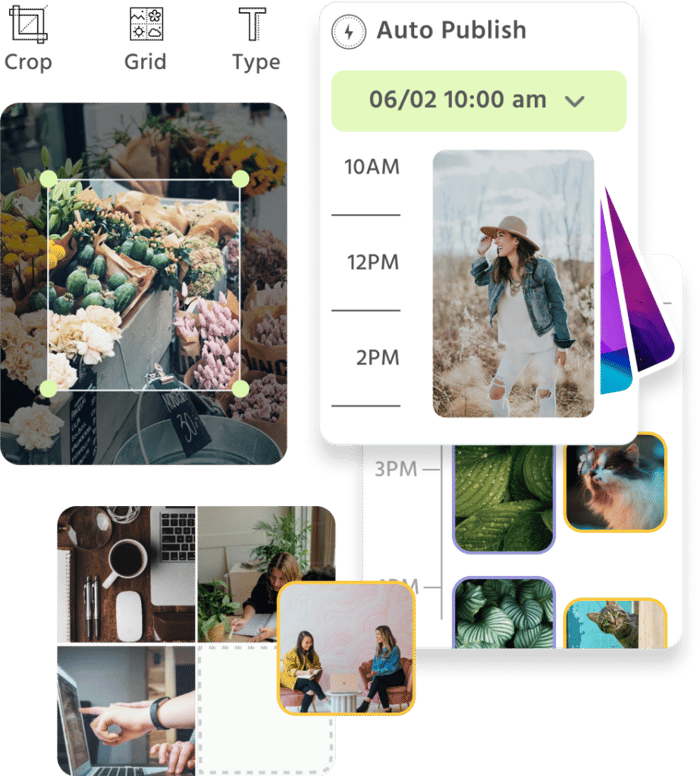
Manage all your social media accounts in one place.
Craft, schedule, & auto-post content to all your social channels, then track analytics and manage interactions from a single, easy-to-use dashboard.
What is Instagram?
Instagram is a social media network launched in 2010 by Kevin Systrom and Mike Krieger. Initially, the photo sharing platform was created for iPhones only. But in 2012, it was extended to Android phones, and later that year, it was acquired by Facebook for $1 billion.
Instagram’s content style
Instagram has evolved from a photo-only sharing network to a rich-and-varied visual content platform that appeals to the young generation. It remains a mobile-only creation platform even though users can now view content on desktop.
Here’s a selection of the different content you may encounter on Instagram:
Photos
Users can take, share and edit photos to share with their followers. Each post can include captions and hashtags. Users can also apply built-in filters to their images.
Videos
Instagram added video sharing in 2013. Initially, videos were limited to 15 seconds but were later increased to 60 seconds long.
Instagram has since added long-form video called IGTV, where videos can last up to 60 minutes long when uploading from the web.
Stories
Instagram also allows users to post “stories”, a type of disappearing content that appears at the top of a news feed for 24 hours unless you add them to your profile as story highlights.
Live video
You can share a live video to connect with your followers in real-time for up to one hour. Once a live video has ended, you share a replay of it to IGTV or share it from your Live Archive.
Messaging
You can send direct messages to one or more people and include content such as posts, photos, videos, stories, and hashtags. You can also video-chat with up to 8 people using messaging on Instagram.
Reels
Instagram Reels is a new feature that allows users to record and edit 15-second multi-clip videos with audio, AR effects, and new creative tools. The idea is for people to express themselves while entertaining others, like trying out a dance. In short, like Instagram took Stories from Snapchat, the idea of Reels is borrowed from TikTok.
Boosted Posts
Boosted posts on Instagram are an advertising method that allows users to reach a more targeted audience. You can define their audience segmentation based on interests, behaviors, demographics, and more, ensuring a more precise reach that helps you target the right audience for your brand.
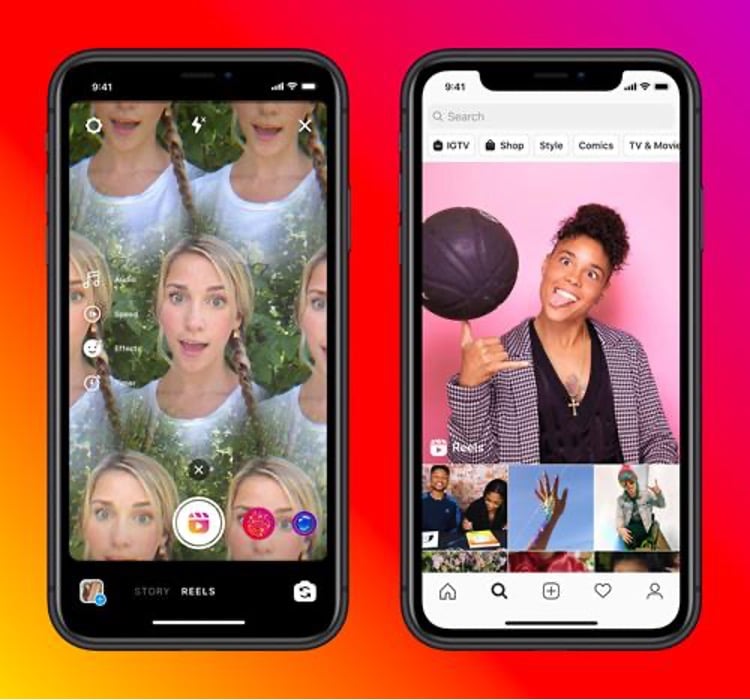
Shopping
Instagram Shopping is a set of features that allows businesses to sell their products directly to customers inside the app.
Instagram’s audience
Instagram is most popular with young people. A third of its users are aged between 25 and 34 years, and over two-thirds are aged 34 years and younger:
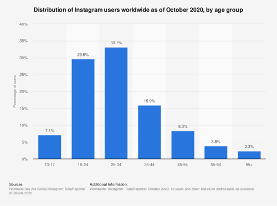
Instagram is especially popular in the United States with over 140 million users, followed by India (120M) and Brazil (95M):
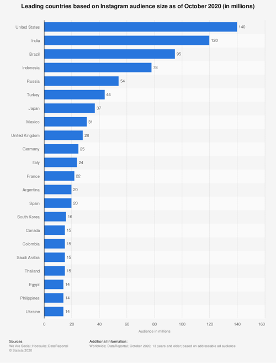
It’s forecast that the number of Instagram monthly active users (MAUs) in the US alone will pass the 120 million mark in 2023:
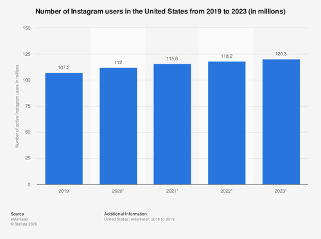
Instagram’s engagement
Instagram has over 1 billion monthly active users, and over 500 million users interact with its popular Stories feature daily:
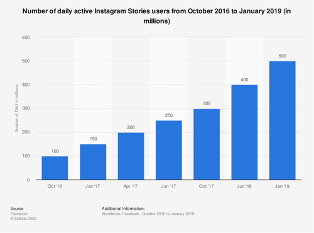
It’s the second most accessed network behind Facebook, where users browse for an average of 53 minutes per day and upload 60 million photos every day.
- 90% of people on Instagram follow a business.
- 2 in 3 people surveyed say that Instagram enables interaction with brands.
- 50% are more interested in a brand when they see ads for it on Instagram.
Who is Instagram — and Instagram Marketing — for?
People come to Instagram to be inspired and discover things they care about, which includes content from brands and businesses:
- 83% of users say they discover new products and services on Instagram.
- Over 200 million Instagrammers visit at least one business profile daily.
- One-third of the most viewed stories are from businesses.
There’s a diverse mix of B2C and B2B brands, influencers, celebrities, creators, and artists who use Instagram for their business.
But that doesn’t necessarily mean it’s right for your brand. You need to consider:
- Your goals: If you’re looking to increase brand awareness, build a community, and sell online products, then Instagram is an ideal choice.
- Your audience: If you’re targeting young adults aged 18-34, then Instagram is perfect.
- Your competitors: If your competitors are using Instagram successfully, then there’s a good chance it will work for you, too.
- Your resources: If you have the time and skills to create top-notch visual content, Instagram will suit you.
Successful Instagram Marketing Campaigns
Let’s take a look at some of the content from successful brands on Instagram.
Lego – Video content
Lego is one of the most followed accounts, but they’re still creative with their marketing campaigns, which use various short and long-form videos.
Watch some of their videos to get an idea of their originality. (Hint: they don’t always include Lego bricks.)
FedEx
FedEx posts are mainly photos featuring their delivery drivers, vans, and planes in action. But they also feature photos shared with them by followers, which is a great way to engage their fans and encourage them to photograph and share the FedEx brand.

Oreo
Oreo features their product in a fun and highly engaging way, like this hidden photo of “delicious content” with the entertaining copy:
“This photo contains craveable content which some people may find…well, irresistible.”
Their photos and images are high-quality, often using solid, vibrant backgrounds with their brand blue color to make their posts stand out in the Instagram feed.
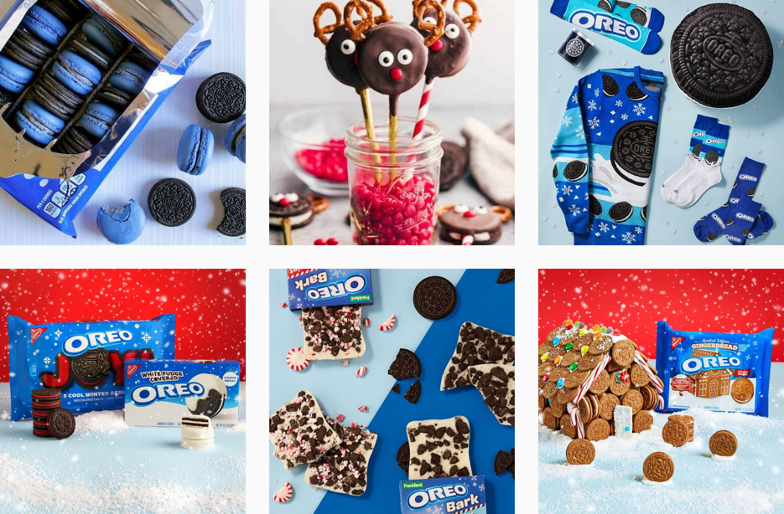
How to Harness the Power of Instagram Marketing in 2021
If you’re getting started with Instagram, decide which story you want to tell, choose a cohesive look and feel for your account, and post consistently.
Let’s take a look at how to do that with these six steps:
- Step 1 – Setting your goals
- Step 2 – Branding your profile
- Step 3 – Creating and optimizing your content
- Step 4 – Publishing your content
- Step 5 – Promoting your content
- Step 6 – Measuring your performance
Step 1 – Setting your Instagram marketing goals
Without goals and objectives, you can’t measure performance.
So before you start creating a profile and posting content, it’s essential to know how Instagram fits into your business strategy and what goals you have.
You need alignment from business goals to marketing goals to Instagram goals.
For example:
- Business goal – increase customers
- Marketing goal – increase leads and conversions
- Instagram goal – increase followers and engagement
- Marketing goal – increase leads and conversions
There are other Instagram goals you may want to consider, such as:
- Building brand awareness and reaching more of your ideal customers.
- Showcasing your products and services.
- Growing an engaged community.
- Increasing brand loyalty.
You’ll circle back to these goals when you reach the final step and analyze your performance.
Step 2 – Branding your profile
Your profile creates a first impression with users, so you have to make it count. One way to achieve that is to brand your Instagram profile the same as your other social media profiles so that users instantly recognize you.
You don’t get much space to tell users what your account is about, so you have to maximize your description.
There are four main factors to building a solid profile on Instagram – your bio, profile image, website link, and Story highlights.
Your bio description
Make sure your profile bio describes what your brand is, what you do, what you offer, and who you help. For example, Susan Crawford Vintage states she is a knitwear designer and author of The Vintage Shetland Project:
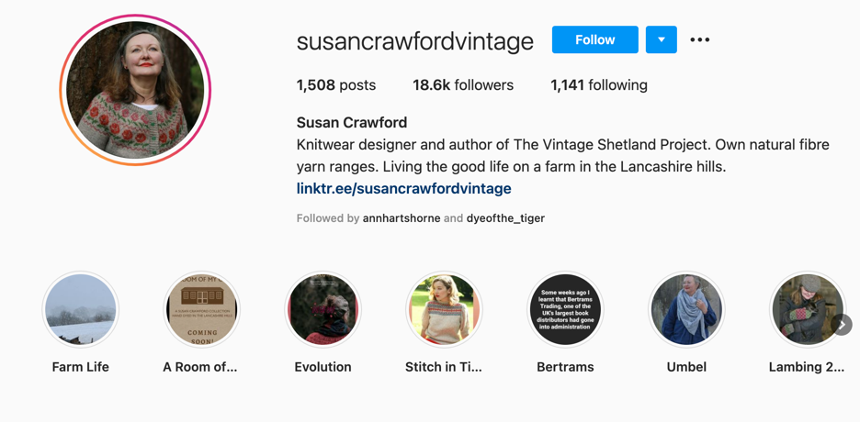
Your profile image
Your profile image could be a logo or a photo depending on your brand. For example, you can see above that Susan Crawford uses a photo to promote her brand, but logistics firm FedEx uses its logo:
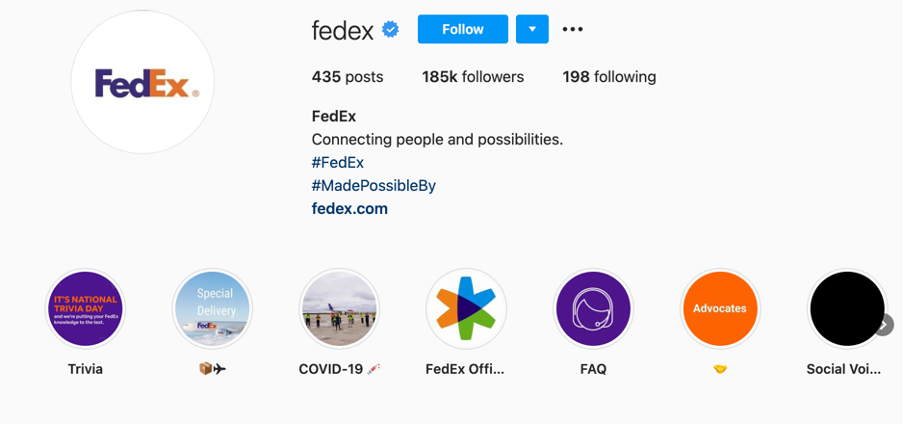
Your website link
You can only have one website link in your bio, so it’s essential to maximize the opportunity. However, you can change it when you wish and direct your audience to different landing pages.
To get around the restriction, you can use a “link” service like Linktree or Linkin Bio.
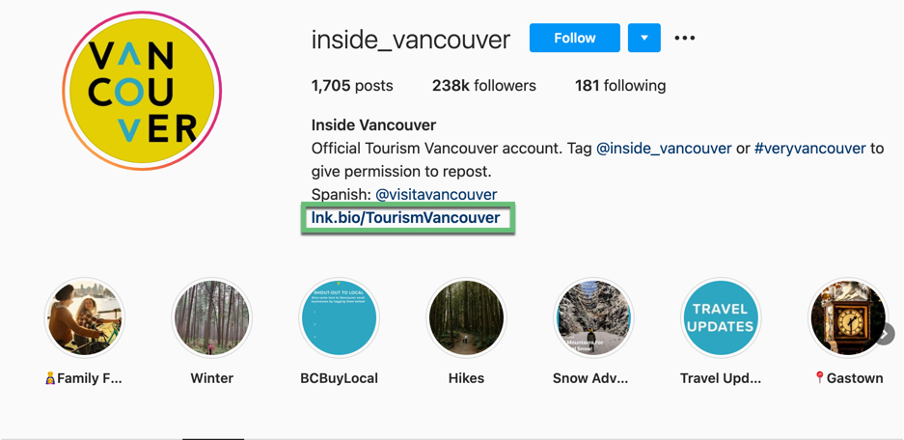
For instance, Inside Vancouver uses a lnk.bio/TourismVancouver, which has one link going to a selection menu of different pages:

Your story highlights
Instagram Story Highlights remain on your profile permanently rather than disappearing after 24 hours like regular Stories. They have a prime location directly under your bio and above your Instagram feed, as seen here on Oreo:
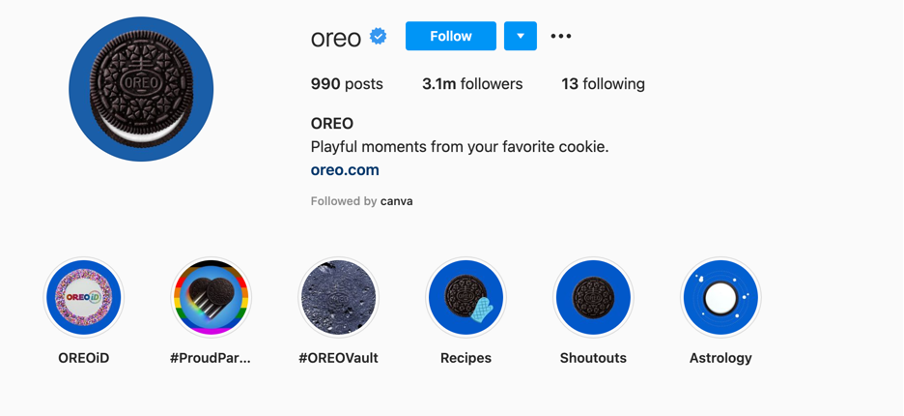
Step 3 – Creating and optimizing your content
Instagram is a visual platform, so it’s vital that you post high-quality images, photos, and videos. Low-quality content creates a poor impression, and users will likely scroll by looking for something more appealing.
Successful brands have one thing in common: consistency.
They have a cohesive look-and-feel to their account so that it’s instantly recognizable by the color scheme, the type of photo or video shared, the tone of voice used in captions and on images, the hashtags used, and the way they interact with users.
Let’s take a look at some of the options for creating and optimizing your content on Instagram.
Captions
Although Instagram is a visual platform, captions are a great way to complement the image and support your message using the right tone of voice.
Captions can be up to 2,200 characters long, so you can use them for short snappy statements, as we saw above with Oreo:
“Warning: irresistible cookies await you.”
Or long stories, like National Geographic:
Here are some tips to help you write captivating captions for your Instagram posts:
- Remember your brand tone and voice
- Know your audience
- Intrigue followers with stories
- Add some emojis
- Use some relevant hashtags
- Ditch the hard sell
- Insert a call-to-action
- Make sure your copy is error-free
Hashtags
You can use up to 30 hashtags in an Instagram post, but using too many hashtags looks spammy and can turn visitors away. The optimal number is between 5 and 10.
You can use hashtags in or after your caption, or you can add them in the comments section. The key is to be consistent and stick with one place for your cohesive look and feel.
For instance, Grammarly always posts hashtags in the first comment:
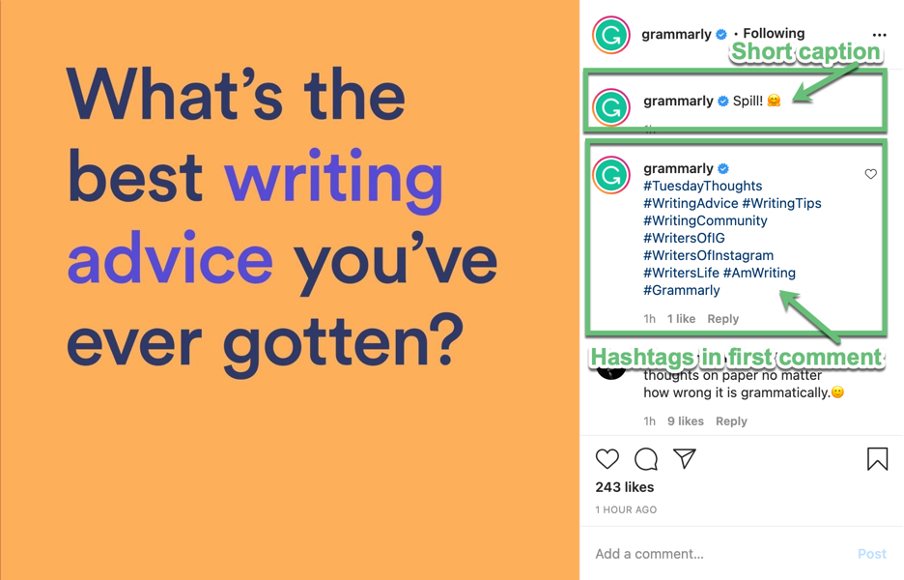
Whereas Lego includes them in the caption:
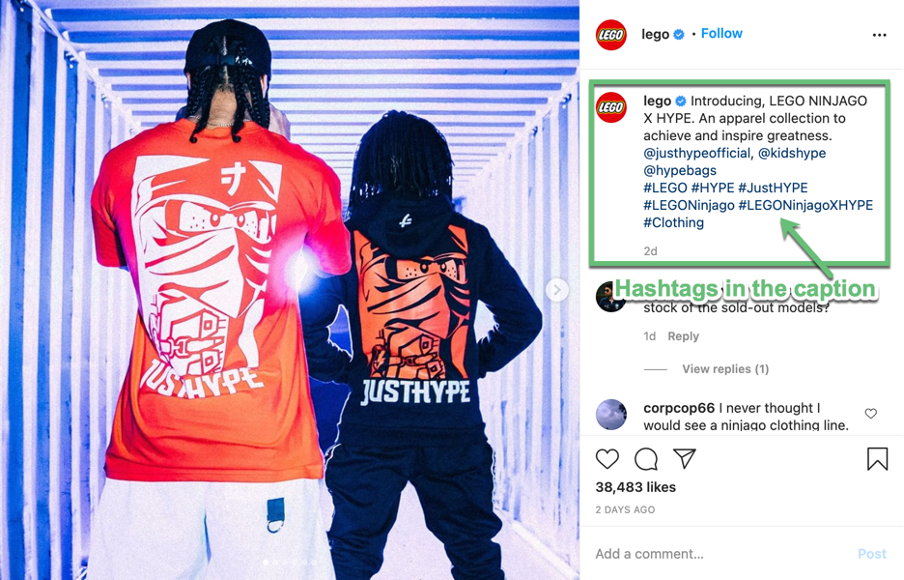
You can also include hashtags in your profile bio and Instagram Stories.
Stories
Stories are growing 15x faster than the traditional Feeds on all social media platforms. So it’s hardly surprising that most new features launched on Instagram involve the Stories format and stickers. For instance, you can:
- Add a donation sticker to allow people to donate to a nonprofit that you care about.
- Add a challenge sticker to participate in popular challenges.
- Add a quiz sticker to write your own multiple-choice question and customize the answers.
- Add a countdown sticker to count down to any moment, such as building anticipation for a product launch.
- Add a questions sticker so people can ask you a question or send you a song.
- Add a music sticker and search for a song.
- Add a poll sticker or emoji slider sticker to write your own question and customize the answers.
- Add a location sticker by searching for or selecting nearby options.
- Add a hashtag
- Add a current time or weather
Instagram even added a couple more new features to help businesses through the pandemic:
- Add a Gift Card Sticker to sell digital gift cards.
- Add a Food Order Sticker to order food items.
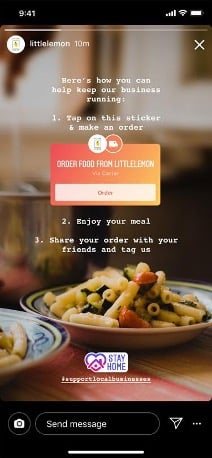
Instagram Stories are a quick, easy way to share moments and experiences. You can use text, music, stickers, and GIFs to bring your story to life. And, generally, they can be a little more unpolished than your regular Feed content.
Stories are successful because they create the best replication of a social experience — they make our brains light up with the recognition of knowing another person.
- One-third of the most-viewed Stories are posted by businesses.
- Brands post an average of 5 Stories per week on Instagram.
- Brands pay Instagram influencers between $43 and $721 for Stories.
- U.S. marketers spend 31% of their Instagram ad budget on Stories and 69% on the News Feed.
Stories Highlights lets you share your Stories for more than 24 hours by posting them as highlights on your Profile.
For example, Sephora uses highlights albums to showcase their different product categories:
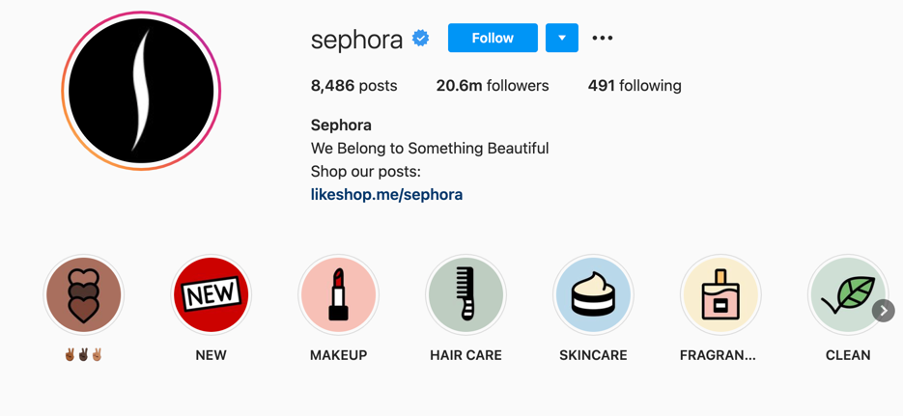
Reels
Reels are the latest feature to hit Instagram. The short-form video and audio clips rival TikTok. But businesses are using them successfully. For example, Sephora features user-generated content demonstrating how to apply their makeup products:
IGTV
Instagram’s IGTV allows you to upload long-form videos to your profile, rather than the Feed. So now you have up to 60 minutes instead of 60 seconds to engage your audience.
Live
Instagram gives you the option of broadcasting live videos, which can also run for 60 minutes. After a live video has ended, it’s no longer visible in the app, but you can share a replay of it to your Story.
Shopping
Instagram Shopping is a set of features that lets people buy your products within the Instagram app. They include:
- Shops – A customizable storefront allowing people to shop directly on business profile pages.
- Shopping Tags – Allow brands to highlight products from their catalog in Stories and the Feed so that people can learn more.
- Instagram Shop – An in-app shopping destination where people can discover products and brands they love.
- Collections – Allow businesses to customize their shop by curating products into themes.
- Checkout – Allows all eligible businesses and creators in the US to sell their products directly on Instagram with Facebook Pay instead of sending customers to third-party stores like Shopify.
- Live Shopping – Unlocks a new channel for checkout-enabled businesses to sell products through their Instagram Live broadcast in real-time.
Step 4 – Publishing your content
Now you know how to create and optimize your content, it’s time to consider when and how often to publish your content.
Let’s take a look.
What’s the best time to post on Instagram?
The short answer is: it depends.
Google has over 5 billion results for the query: “What’s the best time to post on Instagram?”
Every brand and their audience is different, so it’s impossible to give one answer. What works for one brand won’t work for another. So it’s a case of experimenting to see what works best for you.
However, it is important to post consistently. So aim to publish a steady amount each day rather than jumping from one extreme to the other.
Scheduling content
Putting all these elements together, it makes sense to plan your content with an editorial calendar so that you get the right mix and timing.
Plus, when you’ve finished experimenting and know when and how often you’re going to publish content, you’ll want to consider using a scheduling tool to make sure everything gets posted at the right time.
Step 5 – Promoting your content
After you’ve created, optimized, and published your content, you’ll want to start engaging your audience and promoting your content.
Engage with followers
Instagram marketing involves listening and responding, as well as posting. So make sure you engage with your followers by responding promptly to comments and messages on your posts.
Also, keep an eye out for mentions by other users. If users tag you in their posts, then make sure you share their content. You could try the Share Feed Posts to Stories feature that includes the original poster’s username and a link back to their post.
Interacting with followers is a great way to encourage more engagement on your posts.
Partner with other brands and influencers
Instagram is one of the most active social media channels for influencers who can have a significant impact when it comes to promoting your content. Almost half of daily Instagram users have made a purchase because of an influencer recommendation.
If you decide to partner with an influencer, make sure their audience is genuine (no fake accounts and inflated follower numbers) and aligned with your product or service.
Another promotion option you can try is an ‘unpaid shout-out’. In this scenario, you partner with another brand that has about the same number of followers as you to promote each other to your audiences, so both parties benefit.
Both of these options are a great way to promote your products to a new audience and gain a large number of new followers quickly.
Source user-generated content
You may have noticed from the earlier examples how many brands encourage and share user-generated content (UGC). It’s a win-win scenario. Fans and followers get exposure for their Instagram profile, while you get ‘free content’.
UGC is an excellent way of demonstrating the authenticity of your account and building your community. And when fans show how they’re using your product, you’re onto a winner.
Once you share one follower’s content, it encourages other followers to post content about your brand in the hope they’ll get a mention.
Run a contest
Instagram contests are a popular strategy for generating brand awareness. Before you decide to host one, make sure you check Instagram’s promotion guidelines.
You can run different types of contests you can, including:
- Tag a friend in the comments
- Follow us
- Leave a comment
- Photo contests
Each contest may have a combination of the above, plus there’s usually a contest specific hashtag to use as well so that you can build momentum.
Try Instagram ads
Instagram ads offer a cost-effective way to promote existing posts and reach new people beyond your followers. There are various types of ad format, including:
- Stories ads
- Photo ads
- Video ads
- Carousel ads
- Collection ads
The quickest way to run ads is by promoting content that you’ve already published. Just select the post you want to promote, and then track how many people are seeing and interacting with it.
You get to target the audience you want to reach using Instagram’s targeting options and set the budget you wish to spend.
Step 6 – Measuring your performance
The final step in harnessing the power of Instagram is to measure your performance. After you’ve created, optimized, shared, and promoted your content, you’ll want to see what impact your posts have made.
Key metrics
Instagram Insights is split across three tabs – Activity, Content, and Audience – and covers your overall account plus individual posts and stories.
Post-level metrics:
- Likes: People who positively reacted to your posts.
- Replies: People who have commented on your post.
- Story metrics: The number of views on your stories and the average time of engagement.
Account-level metrics:
- Discovery / Reach: The total number of unique accounts who have seen your feed.
- Impressions: The number of times all of your posts were seen.
- Follower count: Amount of people subscribed to see your posts.
- Interactions: The combined number of profile visits and website clicks.
- Profile visits: How many people visited your profile over a seven-day period.
- Website clicks: How many people clicked the link in your account bio in a seven-day period.
- Audience metrics: The data-based breakdown of your audience demographics.
Evaluate and adjust
Like all marketing plans, you’ll need to evaluate your Instagram marketing strategy to ensure you’re hitting your goals and objectives. If necessary, be prepared to make adjustments where needed so that you can improve your performance.
Instagram Marketing in a Nutshell
Let’s wrap up this Instagram marketing guide with a quick recap of the key points:
- Make sure you brand your Instagram profile and maximize the limited space.
- Optimize your content with the latest features to boost engagement.
- Publish content consistently to build your presence on the platform.
- Build an active community to help amplify and promote your content.
- Analyze your Instagram marketing performance to see where you can improve.
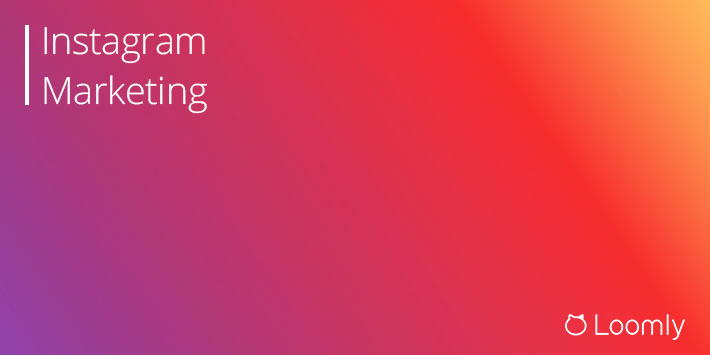
.png?width=352&name=Blog%20featured%20image_Reels%20vs%20Posts%20(1).png)

